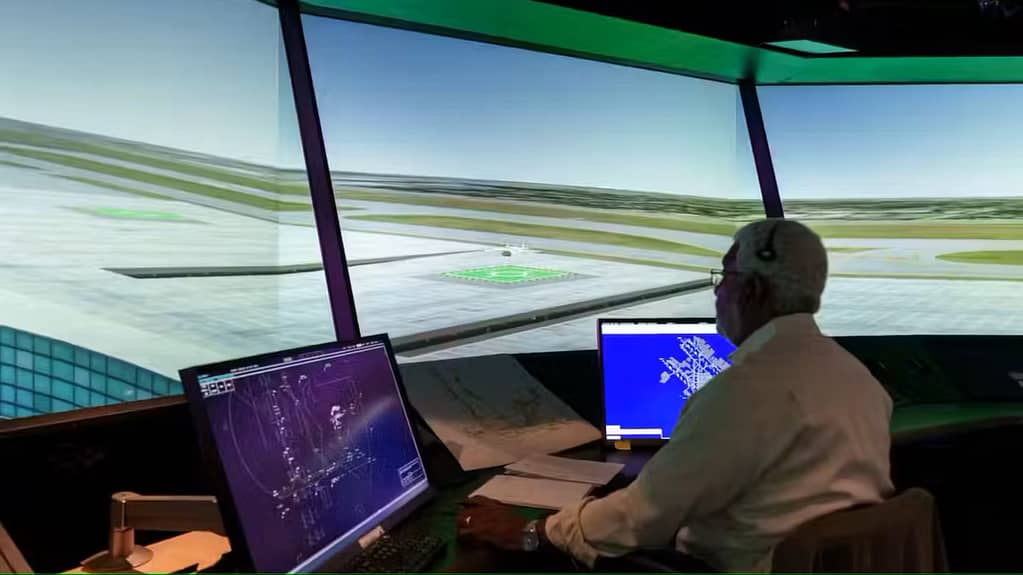In a cutting-edge collaboration, NASA and eVTOL manufacturer Joby Aviation conducted groundbreaking simulations, virtually deploying hundreds of electric vertical takeoff and landing (eVTOL) air taxis over the Dallas-Fort Worth area. Let’s delve into the details of this visionary project.
The dynamic partnership initiated a series of simulations, utilizing NASA’s FutureFlight Central virtual tower facility to explore the integration of air taxis into complex airspace. Active and retired air traffic controllers participated, testing current tools and procedures for seamless air taxi operations.
Table of Contents
A Glimpse into the Future: Current Tools for Tomorrow’s Air Taxis
NASA researcher Ken Freeman expressed confidence in the project’s success, emphasizing that the simulations validate the safe integration of eVTOLs into the airspace at scale. The focus is on utilizing existing air traffic control (ATC) tools and procedures for a smooth transition.
Preparing for Takeoff: U.S. Airports Gear Up for eVTOL Services
With eVTOL air taxis expected to hit the skies around U.S. airports by 2025, NASA and industry partners are collaborating with the FAA to demonstrate the compatibility of existing ATC tools. The goal aligns with the FAA’s Innovate28 philosophy, utilizing current regulations and infrastructure for early air taxi operations.
Human-in-the-Loop Simulations: Testing the Limits at NASA’s FutureFlight Central
The simulations, conducted with active controllers at NASA’s virtual tower facility, simulated traffic patterns over Dallas Love Field and Dallas-Fort Worth International Airport. Controllers evaluated the impact of up to 120 eVTOL arrivals and departures alongside existing traffic, showcasing the feasibility of air taxi operations.
During the hour-long simulation, controllers efficiently managed up to 45 simulated aircraft in virtual Class B airspace. The success of the tests demonstrated the ability of air taxi operations to coexist with active airport traffic, using established routes and procedures.

The Promise of Advanced Air Mobility: Momentum and High-Fidelity Simulations
The positive momentum in advanced air mobility is undeniable. Joby’s air taxi product lead, Tom Prevot, highlighted the successful simulations as a result of meticulous planning and collaboration. Observers from NASA, the National Air Traffic Controllers Association, and stakeholders witnessed the seamless operation of eVTOLs in congested airspace.
Scaling the Heights: NASA’s Plan for Nationwide Integration
NASA’s initial analysis indicates that the procedures tested could be scaled for operations at airports nationwide, reducing ATC workload. The regulator plans to publish a comprehensive analysis next year, sharing crucial data with the FAA, airports, and the commercial industry to facilitate near-term and future air taxi integration.
Beyond the Skies: NASA and Joby’s Vision for Air Taxi Quality of Life
Enabling eVTOLs as a taxi service holds the promise of reducing carbon emissions and enhancing the passenger commute experience. NASA envisions a future where air taxis shuttle passengers to and from airports, revolutionizing travel with shorter commute times.
Towards a Better Quality of Life: Air Taxi Integration Redefining Travel
The joint simulation campaign is a result of years of collaboration between NASA and Joby, exploring multiple use cases for eVTOL operations. Their shared goal is to bring about changes to the national airspace system, enabling air taxi integration on a broader scale.
Urban air mobility researcher Savvy Verma emphasized the potential for a better quality of life, particularly for those facing hours-long commutes. The vision is to convert a 45-minute trip into a swift 15-minute journey, marking a paradigm shift in transportation efficiency.
Stay ahead of the curve in the world of technology! For the latest updates, groundbreaking innovations, and in-depth analyses, don’t forget to visit our dedicated Tech Section. Dive into a world where technology shapes the future, one breakthrough at a time. Click here to explore more